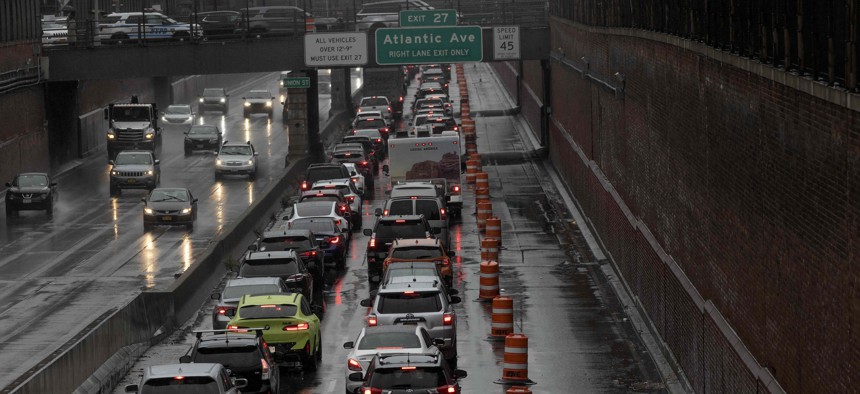
Andrew Lichtenstein/Corbis via Getty Images
Legacy programs stymie Biden's efforts to boost equity in infrastructure spending
Communities of color benefit when federal agencies pick transportation projects, but most infrastructure money is doled out using old rules that favor whiter areas, according to a new report from the Urban Institute.
A new report finds that federal agencies have heeded one of President Joe Biden’s top promises for infrastructure spending: that it be directed to help communities of color.
But that success has largely been limited to the few areas where federal agencies get to choose projects, not to the vast majority of infrastructure spending that Congress allocates with decades-old formulas that automatically give states and localities a predetermined share, according to the Urban Institute.
The report is one of the most extensive looks yet at how well federal agencies are living up to the promises of bringing infrastructure improvements where they are needed most. Urban Institute researchers examined federal infrastructure spending through dozens of programs during 2022, the first full year Biden’s infrastructure law was in place. They tracked where the money was spent, down to the neighborhood level. And they analyzed how well that corresponded to the infrastructure needs, income levels and demographics of those areas.
The team also found:
- Counties that have relatively few employees won fewer competitive federal grants than counties with more bureaucratic capacity. Doubling the number of local transportation staff increased a county’s chances of winning one type of major federal grant by 31%. “There seems to be a very clear relationship between capacity and winning a grant, no matter what the program, no matter the location of that county or state,” said Tomi Rajninger, one of the report’s authors.
- Federal competitive grants disproportionately went to higher income counties, which could be a sign that the process of applying for federal infrastructure grants is too cumbersome for lower income jurisdictions. Researchers found, though, that the more affluent counties that won those federal grants tended to use them to improve lower income communities within their boundaries.
- Programs designed to improve broadband service and transit do appear to be targeting places that show a significant need for those upgrades. But housing programs “have a less clear relationship” with needs by local residents.
The report, though, highlights some of the difficulties facing the Biden administration as it tries to help communities of color or low-income neighborhoods. The president promised to direct 40% of benefits from federal infrastructure and clean-energy programs to areas that are “marginalized, underserved and overburdened by pollution.” But federal agencies have struggled to agree on how to measure the benefits delivered under the so-called Justice40 initiative, making it difficult to determine whether they are actually living up to that promise.
Yonah Freemark, one of the authors of the Urban Institute study, said the researchers wanted to use other ways to measure equity, because the administration’s definition was “nebulous.” Instead, they looked at whether places with the highest levels of specific needs received funding to address those needs.
One of the Biden administration’s most promising ways for addressing inequities, they found, was through competitive transportation grants. That includes programs like the popular Raise Grants that help states and localities build multimodal projects that have a major local or regional impact.
“Many of the competitive transportation dollars are genuinely focused in communities of color, likely following agency equity plans they have developed over the past few years,” the researchers wrote. “But there is little evidence that the federal government provides progressively more funding to communities with the largest share of people of color or low-income populations, compared to the rest of the country. The federal government could further target grantmaking for these areas.”
On the other hand, Congress allocated the vast majority of spending in the 2021 infrastructure law to programs that use decades-old formulas to distribute money.
Money for highways, broadband and water “tend to disproportionately benefit states with lower shares of people of color because of their emphasis on providing minimum funding to states with low populations and providing substantial support to states with more roads,” the researchers said.
“The result is a doubling down on existing inequitable patterns of infrastructure investment. This is a concern for highway funding especially, given that most federal road funding can be leveraged for other uses, such as public transportation or pedestrian and bicycling projects; states with a higher share of people of color are missing out on a fair share of funding that they can use for the transportation investments of their choice,” they argued.
What’s more, the advantage for disproportionately white states isn’t just a matter of those states having more rural highways that need upkeep, Freemark said. “We actually found that there was no statistical difference in the amount of money that was going to states with more or fewer highways per capita,” he explained.
The report also highlighted other ways that older formulas don’t match current needs. For example, the Department of Housing and Urban Development distributes money for public housing. But with so little public housing being built in recent decades, those funds often favor places that built housing in the 1960s and 1970s, rather than the places that need housing now.
In other words, the formula programs tend to reinforce current conditions rather than prepare states and localities to make needed changes. They “are not designed to assist communities that want to make change or require communities to address longstanding exclusion—instead, they often reinforce decades of policies rooted in systemic inequity,” the researchers wrote.
More detailed information on how various infrastructure funds were distributed at the local level can be found here.







